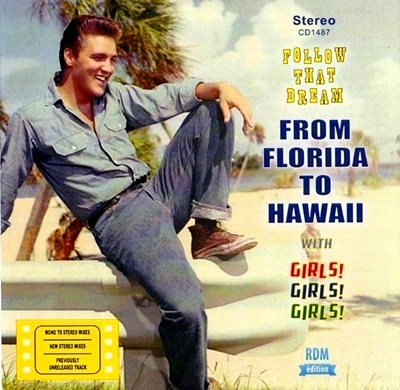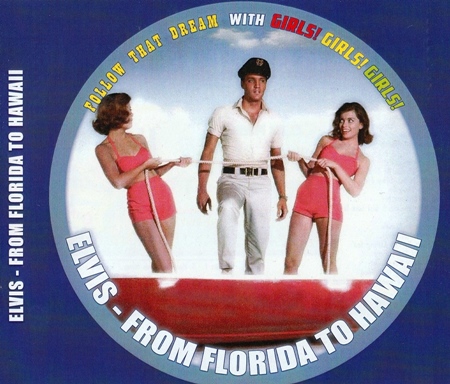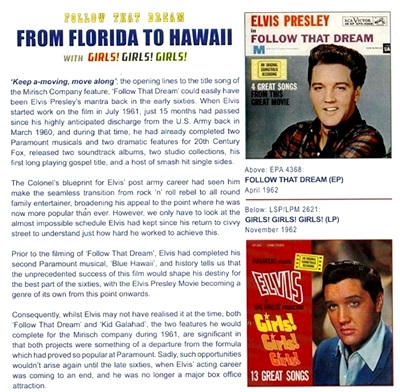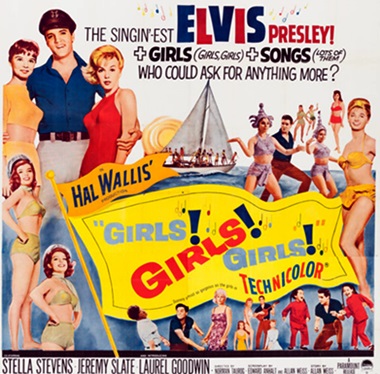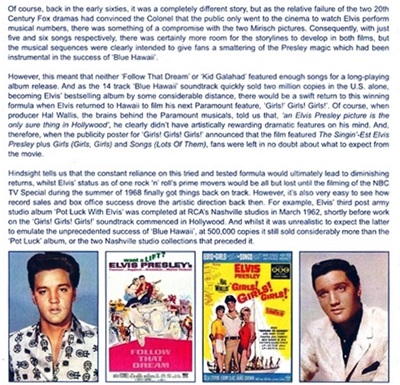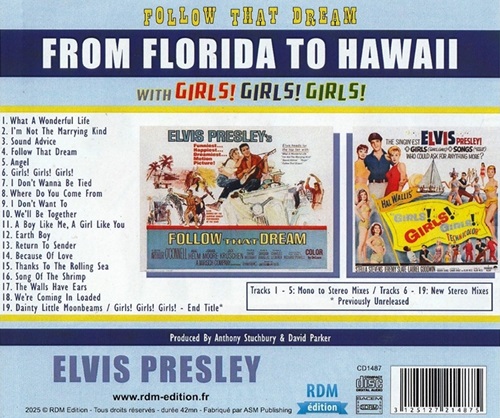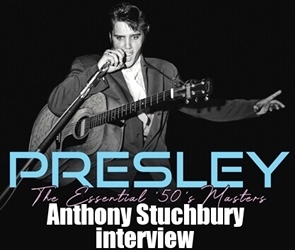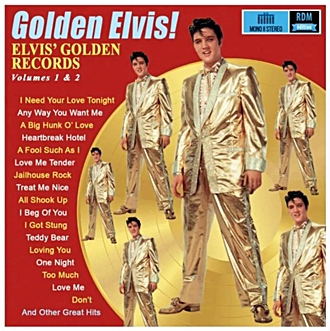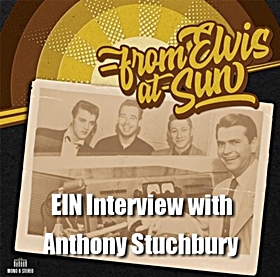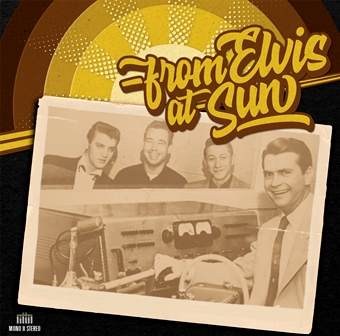 |
 |

Following RCA’s ‘Summer Vacation Special’ marketing, the French RDM-Edition released a Spring compilation featuring music from the upbeat ‘Follow That Dream’ and ‘Girls! Girls! Girls!’ soundtrack albums on a delightfully named 'From Florida To Hawaii'. Is it a good teaser for Summer 2025? EIN’s Piers Beagley and Elvis Day By Day’s Kees Mouwen get together once again to discuss what makes this 2025 remaster of these two Elvis sixties soundtracks worth buying. Piers: There is an explanation, that Elvis collectors need to understand, as to why so many of Elvis’ movie soundtracks lacked real production values. The easiest way to produce film soundtracks with the early sixties 3-track tape recorders was to record the musicians on the left channel, Elvis’ vocal centre channel, and backing vocals on the right channel. For the film studios there was always the orchestra, as well as “crowd interactions” to be overdubbed to create the final cinema soundtrack so it was much easier for Paramount (or MGM) to fade down the musicians, or the backing vocals as required if they were isolated on three separate channels. However to cut a properly balanced RCA stereo soundtrack LP it would make more sense to spread the various musicians across the whole stereo spectrum. Elvis’ wonderful Nashville 1960 stereo recordings by Bill Porter for the ‘Elvis Is Back’ sessions demonstrated how well Elvis’ music could be produced for stereo release. There were even some stereo 45rpms released at the time. So for Elvis’ movie productions it would have been far better to record on one 3-track tape recorder with isolated musicians for Paramount production, and on a second three-track tape recorder for a properly mixed stereo RCA release. However this was not the case for Elvis' movie soundtracks where Col Parker saved money by making the movie studios pay for the recording sessions. It would only be afterwards that MGM or Paramount would then hand-over their soundtrack tapes to RCA to be finalised for album release. This is also why so many of Elvis’ soundtrack session tapes have been lost since they were owned by the studios not by RCA. Adding to our woes, the tapes would often be lesser generation taped copies that were handed over to RCA making them sound even worse. Of course to create a quality RCA Master, Parker would have had to pay extra for Bill Porter to be present at the soundtrack sessions plus an extra tape-recorder and also double the magnetic tape. Cheapo Parker would never do that, for him it was always profit over quality. Thus we are left with all too many terribly mixed Elvis soundtrack releases. The recent FTD ‘Girl Happy Sessions’ demonstrated what a terrible job MGM did in recording Elvis’ soundtrack session. On this RDM release Anthony Stuchbury has thankfully done his best to rectify Paramount’s poor production job on Elvis’ ‘Girls, Girls, Girls’ session.
Design The liner notes by David Parker set the musical context for the songs and the versions that were released, and why they have been upgraded for this CD. Elvis’ incredible workload at the time is explained.... "Keep a-moving, move along" the opening lines to the title song of the Mirisch Company feature 'Follow That Dream' could easily have been Elvis Presley's mantra back in the early sixties. When Elvis started work on the film in July 1961, just 15 months had passed since his highly anticipated discharge from the U.S. Army back in March 1960, and during that time, he had already completed two Paramount musicals and two dramatic features for 20th Century Fox, released two soundtrack albums, two studio collections, his first long playing gospel title, and a host of smash hit single sides. The Colonel's blueprint for Elvis' post army career had seen him make the seamless transition from rock 'n' roll rebel to all round family entertainer..” There is also a nod to the fact that while Elvis’ soundtracks initially did well in the charts (‘Girls, Girls, Girls’ out-sold Pot Luck) three movies a year was actually a lamentable plan.. “Hindsight tells us that the constant reliance on this tried and tested formula would ultimately lead to diminishing returns, whilst Elvis’ status as one of rock ’n’ roll’s prime movers would be all but lost until the filming of the NBC TV Special in 1968.”
Content Although the MRS label vinyl/CD ‘Follow That Dream’ EP rightfully received a positive review, this new outing of the soundtrack music matches the authentic (Mono) sound we know from the available stereo outtakes. The songs simply sound more natural compared to the MRS edition. Piers: In the case of the ‘Follow That Dream’ Bill Porter July 1961 Nashville session, the problem is that the well-recorded stereo ‘Masters’ were cut out of the session tapes and lost. For these tracks Anthony Stuchbury has cleverly matched the musicians’ placement to the original ‘Follow That Dream’ session tapes. I particularly enjoyed hearing Bob Moore’s defined bouncy double-bass lines and Hank Garland’s guitar work in this stereo mix. For me, when comparing the MRS and RDM versions I think the bristling clear percussion of the MRS version reminds me of my sixties 45rpms whereas the RDM version is subtler, sounding more similar to an original album release. Kees: Stuchbury has also managed to create a clear separation between the drum kit in the middle and the other instruments on the left, which allows the Jordanaires on the right to shine beautifully. Listen to ‘Sound Advice’ and ‘I Don’t Wanna Be Tied’ and you will hear the guitar on the right instead of the middle, where they should be, and as they are on this new CD.
Girls! Girls! Girls! But while RDM have no outtakes of these songs on offer, there is a real joy in at last hearing this album in stunning 2025 remastered stereo. Although the material supplied was very movie-orientated the musicians - including Barney Kessel and Tiny Timbrell on guitar, Ray Siegel on bass plus Hal Blaine on percussion - were star Hollywood performers who, on the original release, were all mixed down onto the one audio channel. Not forgetting the other musicians Scotty Moore, D.J. Fontana, Bernie Mattinson, Dudley Brooks and Boots Randolph. Kees: ‘Girls! Girls! Girls!’ was originally released in both Mono and Stereo. Many of the releases we have come to accept as “original” were actually shaped by the technical limitations or creative decisions of the time. These choices were made by the artist, the producer, or the engineer, all aiming for a specific sound. Updating the mix for 2025 Stuchbury has used his skills and the craftsmanship familiar from his previous 50’s work. The rhythm section is now placed behind Elvis, resulting in a balanced and immersive audio presentation in which the drums serve as the foundation for the other instruments supporting the vocals. Piers: And what joy it is as ‘Girls! Girls! Girls!’ is an immediate blast. Hal Blaine’s tight percussion kicks off in the centre while the dual guitars of Barney Kessel and Tiny Timbrell are nice and clear on the left channel. Listen to the middle-break with Blaine’s tight cymbals driving Boots Randolph’s sax solo (right) and lovely clear Ray Siegel bass and guitars. This section was always rather flat on the original album whereas now Hal Blaine’s snare riff really flashes. And this is the case with most of this RDM release. By separating out the rhythm section to fill the centre along with Elvis’ lead vocal it opens up the left and right channels for the other musicians who were previously blended together. ‘I Don’t Wanna Be Tied’ similarly has a better hard-focused rhythm section and the mix also elevates Duddley Brooks’ lovely rolling piano (right channel) and there’s some fabulous tic-tac guitar groove going on that I had never noticed before (check @ 0:45). While I always considered this song a typical “movie faux-rocker” there’s more going on from the musicians than I had originally thought. Another joy of hearing these new “Stereo” mixes is when they allow you to spot mistakes you’ve never noticed before. Here when the band stops (@1:48) for the “blues ending”, you can now easily hear Dudley Brooks accidentally keep going for a couple of notes! This was obviously not bad enough to warrant another take but it’s these little discoveries that make these newly updated remasters so enjoyable. ‘Where Do You Come From’ sounds beautiful with Elvis’ vocal neatly focussed (as if he is singing in your ear) plus delightful Ray Siegel bass-work. ‘We’ll Be Together’ this was a fascinating Spanish-influenced track that was added to the soundtrack after ‘Mama’ (also composed by Charles O'Curran / Dudley Brooks) was not considered strong enough for release. It was recorded in May 1962, two months after the main session. The backing-vocals by The Amigos were oddly placed left channel on the original version whereas now they are right-channel with the duelling flamenco guitars sounding brilliant. Elvis sings in Spanish on the chorus and rather well too! I for one would have been happy if they had dumped the rather routine ‘World’s Fair’ movie that followed and gone straight to ‘Fun In Acapulco.’ The old-fashioned ‘A Boy Like Me’ benefits from the clarity of the percussion (celeste, chimes and bongos) and power of Elvis’ vocal but it was always soundtrack-filler. ‘Earth Boy’ required for the “Chinese” section of the movie sounds very odd 62 years later when we hear Elvis singing a bad Chin-glish lyric. This stereo mix however gives you a chance to enjoy the walking-bass and odd oriental percussion. Kees: You are right that in today's world composers wouldn't write lyrics as heard on 'Earth Boy' and ... and let's be honest, while possibly acceptable in 1962 they sound ridiculous now. And even in a movie about Elvis as fisherman, what is it with him singing songs about shrimps!. Piers: The fabulous ‘Return To Sender’ remix had been posted on YouTube so we knew how good this would sound. Fans can thank God for Elvis mono singles as the stereo album mix was appallingly weak with all the musicians mixed to the left channel. Now the centred rhythm section really drives the song with a really tight Hal Blaine percussion and a deep Ray Siegel bass. Boots Randolph’s sax is left channel with subtle Tiny Timbrell guitar on the right channel. It all sounds so smooth and with the required stereo punch. (check the youTube clip here) Kees: It’s notable that in some cases Stuchbury diverged from the general mix to create a more balanced sound, for instance on ‘Return To Sender’ where Boots Randolph’s saxophone can now be heard on the left. Moving that instrument to the middle or right side would have left the left channel uncomfortably empty. This is the kind of nuanced decision-making involved in creating a pleasant and well-balanced listening experience. While some of this is certainly subjective, I for one, think these mixes really work. Piers: ‘Because Of Love’ remix benefits from the delightful driving bass-line while Elvis’ vocal is so clear, soaring above as the Jordanaires harmonies. UK rocker Billy Fury spent a day on the movie set of Girls! Girls! Girls! and sneakily decided to record his own version of ‘Because of Love’ which would become a Top 20 UK single before Elvis’ album was even released! While not strong enough for a classic Elvis ‘A-Side’ ‘Because Of Love’, with its latino feel, was far better than the usual soundtrack filler. Composer Ruth Batchelor also supplied Elvis with ‘King of the Whole Wide World’, ‘Thanks to the Rolling Sea’ and ‘Where Do You Come From?’. With the soundtrack already having a latino and Chinese inspiration ‘Thanks to the Rolling Sea’ then added the Sea-Shanty ambiance. A lesser album-filler, this version really benefits from the boosted centred percussion and clear guitars. ‘Song Of The Shrimp’ while often flagged as one of Elvis’ worst soundtrack songs, on this RDM release with the calypso vibe nicely emphasised with the bongos, clap-sticks and marimba no longer compressed onto the one left channel, it is actually quite fun. ‘The Walls Have Ears’ was previously released with all the instruments compressed onto the left channel, but sounds much better now with centred percussion, very fine Spanish guitar work and clicking castanets. Take 12 was the Master and even with the trite lyrics Elvis sounds far more involved than you would imagine. .. .. “So come on baby.. Don’t fight tonight, just dim the lights...” ‘We’re Coming In Loaded’ building up from the delightful boat-engine bass-riff this lightweight song has a surprisingly fine gospel feel. Written by the great Otis Blackwell / Winfield Scott it’s a shame that it runs only 90 seconds. Elvis sounds committed and with the percussion and tambourine nicely centred and funky guitar left channel, this new mix has an ever better groove emphasising the Jordanaires call and response. A delight. Kees: I rarely hear anything strange on these new mixes but here the instruments sound louder when the backing vocals join in. On checking the original version I realised that this change in volume was also present. Still, I wouldn't have minded a small correction on this new mix as it doesn’t sound quite right. Piers: The last ‘bonus track’ is a previously unreleased recording of the Dainty Little Moonbeams / End Title. This version includes a female harmony not heard before. It runs 2.20 compared to the FTD alternate release of 1.57 and includes two extra choruses that were edited out of the final cut. A lovely bonus for collectors. Kees: Listen to it closely and you will hear tape splices - present in the original source provided by Keith Flynn - which were actually used in the film.
Overall Verdict: RCA have similarly been doing recent “remixes” with the Nashville sessions and MEMPHIS box-sets that both went back to how Elvis recorded them in the studio. However on this release Anthony Stuchbury has kept to the original recordings as they were released back in the day, and purely opened up the dull Paramount movie-mixes to create new STEREO versions that really sparkle. We have now moved from 'Mono II Stereo' to Stereo Remixing, with A.I. and craftsmanship breathing new life into Elvis’ music. We can see why this set was quickly Sold Out and immediately re-printed as it is an audible delight and includes the dynamic mixes that Cheapo Parker, or RCA, should have no doubt paid for in the first place.
Go here to RDM to order only 16.20€ (with 40% off) and check the STEREO audio samples Review by Piers Beagley & Kees Mouwen. Click here to comment on this review
See EIN review of 'Young Man With The Big Beat'. See EIN review of 'Elvis Is Back!' Legacy Edition review: See EIN review of 'On Stage' 40th Anniversary LEGACY in-depth review: See EIN review of From Elvis In Memphis (40th Anniversary Legacy Edition) EIN Website content © Copyright the Elvis Information Network.
Elvis Presley, Elvis and Graceland are trademarks of Elvis Presley Enterprises. The Elvis Information Network has been running since 1986 and is an EPE officially recognised Elvis fan club.
\
|
|





